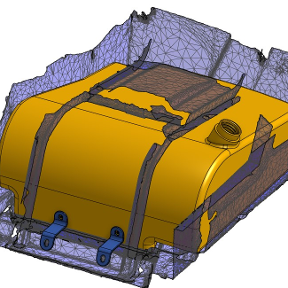Welcome to the Onshape forum! Ask questions and join in the discussions about everything Onshape.
First time visiting? Here are some places to start:- Looking for a certain topic? Check out the categories filter or use Search (upper right).
- Need support? Ask a question to our Community Support category.
- Please submit support tickets for bugs but you can request improvements in the Product Feedback category.
- Be respectful, on topic and if you see a problem, Flag it.
If you would like to contact our Community Manager personally, feel free to send a private message or an email.
Best Of
Re: I absolutely love Onshape!
Yeah the reason I don't post much of my FeatureScript endeavors on here is because there's a lot I can't demo. I did do some demos on Onshape's old podcast Innovator's Insider, but those are pretty old. The only video I know we have is from LiveWorx 2023, where I do a few quick demos on some specific custom features. But our workflow is more about the sum of its parts instead of focusing on a few custom features, and currently I can't demo that in its entirety.
I can talk about a few ways we've leveraged the API to work with templates and I can discuss some of the ways we've put attributes on parts to create a system where parts can talk to each other in order to enforce business rules. That might be better suited to a private message or a call. Shoot me a message if you have more questions.
Re: Workflow for Tolerancing/Different Manufacturing Processes
Configurations sounds like what you are after. You could have one for 3d print, one for CNC.
Suggest using move-face features for your tolerancing. Then you can change the value with a configuration. Or, have one move face for CNC, and a second for 3d print. Then control their supression with the configuraion.
As a check, do you really need two versions? 3D printers are quite good these days. Holes still tend to come in a hair undersized, but the rest of the model is usually pretty good. Holes are usually for screw clearance, so even if undersize, they might still work.
Re: Part naming/ID after breaking a part into three pieces
I'm not sure if the "assign identity" FS would help here (https://cad.onshape.com/documents/fcf31e8bc171b06037008400/v/7e1b5b2304e2bd6d9223a41a/e/e076332e1669ea9babcaf65b)… maybe worth a shot.
However I have to ask why you are combining into a single part and later trying to extract a single key from that… This seems like a strange workflow and I suspect there might be a better way of doing what you are trying to achieve but it's hard to tell without knowing what you are trying to do…
Re: I absolutely love Onshape!
I did a set of stairs in Onshape then imported to VW. Now I originally modeled in VW and that was ok until someone decided to change the vertical height (fl to fl) by 1/2". The stairs shown I can adjust an inch up or down and everything updates, railings and all with just one dim change.
Re: how to make a gear
Use this custom feature: https://cad.onshape.com/documents/5742c8cde4b06c68b362d748/w/b493e0cb681bbf9497d9f4b3/e/c72760543a0d4412e72f6d38
 _anton
_anton
Re: Joining 2 tubes of different diameter
Here are a couple optons.
Re: 3D Connexion SpaceMouse - Not working
Not sure why, but every so often I need to restart the 3dxNLServer to get mine working with Onshape again. To do that I
- hit "command+space" to bring up the spotlight search on my Mac.
- Type "3dx" which autocompletes to 3dxNLServer
- Hit "return" to restart it
- In Onshape I use "shift+r" to hard refresh the page.
Kind of annoying, but It also goes really quick.
If that fails a full computer restart seems to help.
Re: I absolutely love Onshape!
Interesting opposing opinion to the I can't take it anymore thread. LOL
Similar story here. What Architectural cad do you or have you used? and which one(s) are crashing?
 MDesign
MDesign
Re: I absolutely love Onshape!
I would say that you're correct and cabinets can just be done with some simple sketches. We've been using 2D for almost 30 years. But we switched to Onshape for a number of reasons, I can highlight a few here.
- 3D, while not necessary for cabinets, is still helpful when dealing with mass customization. Our product is engineered to order and we work with some of the top design firms in the country. Being able to show them their design in 3D is helpful in building out that design. It's also helpful for the manufacturing floor, giving them more ways to see details they potentially never worked on before.
- FS helps make 3D make sense. One of the reasons we never swapped over to something like SolidWorks was because building a cabinet in 3D takes way longer than in 2D, with the only ROI being the above point, which wasn't enough bang for buck. By using templates and custom features, we can whip up a 3D kitchen referencing all of our specifications very quickly. In addition, we've built a lot of metadata into our custom features that allow us to automatically generate real time cutlists of our models. It cannot be stressed enough that without getting our parts from the model, 3D wouldn't make sense for us.
- 3D + FS has reduced on boarding. We are able to bring on new engineers about 3x faster because they now have a way to interact with our specifications, and we have custom features that build our cabinets and add detail. These custom features have business rules built into them that remove the amount of tribal knowledge needed that the cabinet industry is quite notorious for.
These are just a couple reasons, but I would say if we did just swap to Onshape without making these custom workflows and custom features, it would have been difficult to justify doing 3D at all. For many cabinet shops, drawings are just pretty pictures and the carpenter is the artist. We are trying to move some of the artistry to the digital world and we've done that pretty successfully.







